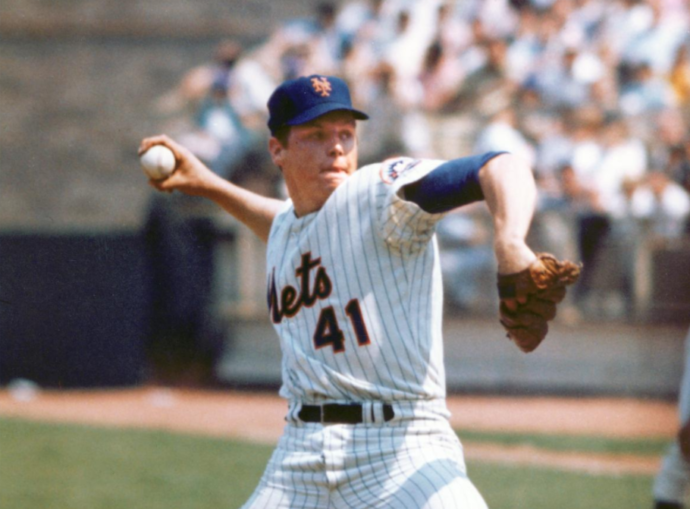
You certainly know the elite seasons by one pitcher: Seaver 1969, Gooden 1985, and deGrom 2018 — just to name a few. But as we imagine the possibilities of two top-line starters in the future Mets rotation, here’s the standard they have to meet. As a point of reference, the primary criteria taken into account for this list were adjusted ERA (or ERA+), pitching bWAR, and influence on high-leverage games.
5. Jacob deGrom and Matt Harvey, 2015
In some cases, the unofficial ace of a tandem is easily the dominant arm (i.e. deGrom in ’18 and ’19). In this instance, it’s more balanced. By the ridiculous standards Jake has laid down now, a 149 ERA+ and 0.979 WHIP are rather pedestrian. But for a pitcher in his second season considered an afterthought when he arrived a year earlier, it was confirmation that he was a fixture. He further underscored that belief with a gutsy effort in the deciding game of the Division Series against Los Angeles. Matt Harvey was arguably more impressive. Overcoming Tommy John Surgery and exceeding the originally-set innings limit, he won Comeback Player of the Year with a 140 ERA+ and 188 strikeouts.
4. Dwight Gooden and Ron Darling, 1985
Doc ’85 alongside any average pitcher would’ve looked pretty impressive. Gooden’s sophomore year stands alone when it comes to Met pitching excellence: 24-4, eight shutouts, 229 ERA+. The numbers are so magnificent they dwarf those around him. Choosing the No. 2 was a toss-up between Darling and Sid Fernandez. Although 22-year-old Sid proved a much-needed left-hander in the Mets’ 98-win campaign (leading the league with 9.5 Ks per nine innings), it was Darling — making 35 starts and appearing in his only All-Star Game — who served as the most worthy complement to Doc’s dominance. Despite a high walk rate, Darling compiled a strong first half and finished with a 2.90 ERA.
3. Jerry Koosman and Tom Seaver, 1968
Predictable spoiler: this pair will come up again. The “Year of the Pitcher” has two Mets examples to fit the narrative. Seaver’s second season was a marked improvement over his first. He began what would become an all-time record nine consecutive years with at least 200 strikeouts — fanning 208. He also posted the third-lowest WHIP of his career at 0.978. Koosman, meanwhile, nearly turned his debut season into a Rookie of the Year Award. He narrowly lost out to Johnny Bench, but it was still good enough to net an All-Star selection alongside Seaver (making his second straight). He bested Tom in wins (19 to 16) and ERA+ (145 to 137), but their combined efforts gave some indication of what the Mets could be if other pieces fell into place.
2. Bob Ojeda and Ron Darling, 1986
More difficult than determining where they belonged on the list was figuring out who to choose from. Ojeda more than validated the trade from Boston that offseason with team-lows in WHIP at 1.090 and ERA at 2.57. He, Darling, and Gooden each had ERAs below 3.00 for a staff that led the NL in that category. You could go either way on Ron or Doc, but Darling gets the nod thanks to a slightly better ERA and a higher bWAR than all other pitchers at 4.4. Both had outstanding postseasons too. Ojeda prevented the Mets from falling into an 0-2 hole in Houston with a complete game and prevented any hint of a Red Sox World Series sweep with seven shutout innings in Game 3 at Fenway. Darling bounced back from a rough NLCS outing to string together 15 straight innings without an earned run in the Fall Classic.
1. Tom Seaver and Jerry Koosman, 1969
When it comes to balanced excellence over a single season and significance towards a team’s ultimate success, there isn’t a better choice. The strategy of the ’69 Mets centered more on preventing runs than scoring them. Seaver and Koosman, as far as on-field contributors, were the linchpins of that philosophy. In the season’s crucial moments, each was at his best. From August 9 through the end of the regular season, in which the Mets won 40 of their final 52, Seaver made 11 starts and went 10-0 with eight complete games. His ERA was a microscopic 1.34. Koosman allowed 11 earned runs over his last seven outings. After beating the Cubs in a September showdown at Shea which propelled the Mets past Chicago and on their way to the division title, he went the distance in his next five games — three of which were shutouts. And they were there when it mattered at the end. Koosman no-hit the Orioles for seven innings en route to a Game 2 World Series victory. Seaver tossed 10 brilliant innings (aided by Ron Swoboda’s catch) to take Game 4. Then Koosman helped write the final chapter of the storybook season — overcoming three early Baltimore runs by allowing just one hit over the final six innings as his offense rallied to take the title.
Others considered: Seaver & Koosman, 1970; David Cone & Gooden, 1988; Al Leiter & Rick Reed, 1998; Mike Hampton & Al Leiter, 2000














